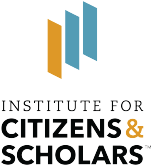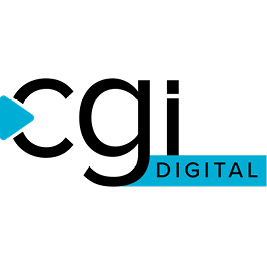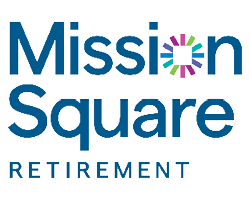2025 All-America City Finalist – Akron, OH
As Akron celebrates its 200th anniversary, the city reflects on a rich legacy of innovation and reinvention. Once a global leader in rubber and tire production, Akron has evolved into a modern center for advanced manufacturing and sustainability, with recent investments positioning it as a national hub for polymer technology. This spirit of progress is matched by a deep commitment to equity, community voice, and inclusive growth.
Facing challenges familiar to many industrial cities—such as population loss, economic shifts, and the lingering impacts of past planning decisions—Akron has embraced a collaborative, people-first approach to shaping its future. With new leadership, engaged residents, and strong cross-sector partnerships, the city is prioritizing accessible development, diverse representation, and bold civic vision. The following initiatives highlight how Akron is translating these values into action through innovative, community-centered projects.
Recycle Right Campaign
In 2019, Akron was grappling with a major environmental and financial issue: nearly 40% of the materials residents placed in recycling bins were non-recyclable. This widespread contamination not only threatened the viability of the city’s curbside recycling program but also led to substantial financial penalties and hindered the city’s progress toward sustainability goals.
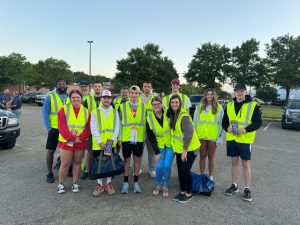 To address the problem, local nonprofit Keep Akron Beautiful partnered with the City of Akron to launch the Recycle Right Campaign. Using funding from the Ohio Environmental Protection Agency, the team developed an educational initiative focused on direct, personalized engagement. Throughout the summer, trained staff visited neighborhoods to inspect recycling carts and leave customized tags with clear, actionable feedback. The goal was to build awareness, correct misconceptions, and help residents understand how to sort their waste properly—all through a hands-on, supportive approach.
To address the problem, local nonprofit Keep Akron Beautiful partnered with the City of Akron to launch the Recycle Right Campaign. Using funding from the Ohio Environmental Protection Agency, the team developed an educational initiative focused on direct, personalized engagement. Throughout the summer, trained staff visited neighborhoods to inspect recycling carts and leave customized tags with clear, actionable feedback. The goal was to build awareness, correct misconceptions, and help residents understand how to sort their waste properly—all through a hands-on, supportive approach.
The campaign’s early rollout faced hurdles, but through perseverance, strategic communication, and community outreach, the program gained traction. By 2024, contamination had fallen to just 12%, and Akron’s recycling program had shifted from a financial drain to a source of revenue and environmental leadership—offering a model for cities nationwide.
Reimagining Akron’s Civic Commons
Akron needed a way to meaningfully connect neighborhoods with vastly different economic and demographic profiles. A three-mile stretch of the Ohio & Erie Canal Towpath Trail highlighted this divide, linking the city’s affluent downtown core with Summit Lake—one of its most underserved and diverse communities.
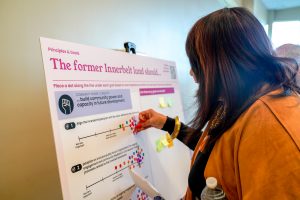 To address this disparity, the Ohio & Erie Canalway Coalition brought together over a dozen partners—including neighborhood groups, cultural organizations, and city departments—to form a Core Team focused on a community-first approach to reimagining public spaces. The team launched an extensive engagement process, hosting hundreds of conversations, workshops, and surveys to gather input directly from residents. Temporary pop-ups like concerts and art installations were venues for seeing what resonated with residents, and trust was steadily built through repeated, responsive interactions.
To address this disparity, the Ohio & Erie Canalway Coalition brought together over a dozen partners—including neighborhood groups, cultural organizations, and city departments—to form a Core Team focused on a community-first approach to reimagining public spaces. The team launched an extensive engagement process, hosting hundreds of conversations, workshops, and surveys to gather input directly from residents. Temporary pop-ups like concerts and art installations were venues for seeing what resonated with residents, and trust was steadily built through repeated, responsive interactions.
This collaborative process led to transformational investments across three neighborhoods. In Ohio & Erie Canal Park, a resident-led steering committee helped shape improvements like new playgrounds, murals, and fitness trails. Downtown saw a more inclusive redesign of major gathering spots, including the $17M renovation of Lock 3 Park. In Summit Lake, community-driven planning resulted in new governance structures, a nature center, a multi-use trail, and the upcoming $6.7M NorthShore Park. With over $30M invested and trust in local institutions nearly doubling in some neighborhoods, Akron’s Civic Commons initiative continues to show how public spaces can become platforms for equity, inclusion, and long-term neighborhood connection.
Akron Waterways Renewed!
Aging sewer infrastructure threatened the historic Cuyahoga River—a vital local resource that provides drinking water and serves as a recreation destination—by allowing millions of gallons of combined sewer overflow to discharge into it annually, creating persistent pollution that endangered public health and the environment.
Akron Waterways Renewed! was created to invest in the city’s environmental future by building wastewater and stormwater infrastructure that will protect public health and maintain water of the highest quality.
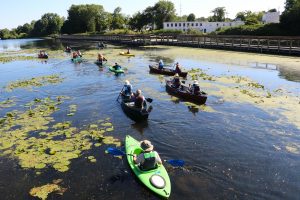 The effort includes 26 major infrastructure projects, including: constructing storage basins, separating portions of the combined sewer system, installing storage tunnels, and upgrading the wastewater treatment plant to increase capacity. Additionally, Akron has integrated green infrastructure projects to increase the effectiveness of the gray infrastructure and provide additional co-benefits for the community and environment. Such projects include implementation of rain gardens, rainwater harvesting systems, permeable pavements, complete green streets, and more.
The effort includes 26 major infrastructure projects, including: constructing storage basins, separating portions of the combined sewer system, installing storage tunnels, and upgrading the wastewater treatment plant to increase capacity. Additionally, Akron has integrated green infrastructure projects to increase the effectiveness of the gray infrastructure and provide additional co-benefits for the community and environment. Such projects include implementation of rain gardens, rainwater harvesting systems, permeable pavements, complete green streets, and more.
The jargon-filled nature of the topic and the significant financial burden on residents necessitated robust community engagement. The city developed an award-winning public outreach program to educate and involve residents—clarifying the environmental benefits and the reasons behind the necessary utility rate increases.
That engagement work has included a formal stakeholder group consisting of the Cuyahoga Valley National Park, Summit Metro Parks, Ohio EPA, watershed groups, industry representatives, residents, and neighboring communities. It also includes city staff bringing information and updates to council meetings and ward meetings as well as facilitating open houses and public tours of infrastructure projects and relevant city facilities.
The results have been transformative! The Cuyahoga River now meets or exceeds water quality standards, supports a thriving ecosystem with the return of key species, and is poised to offer expanded recreational access along its banks.
Some Related Posts
Thank You to Our Key Partners
